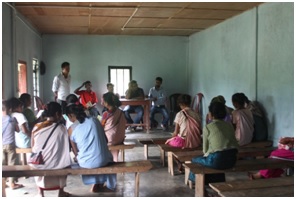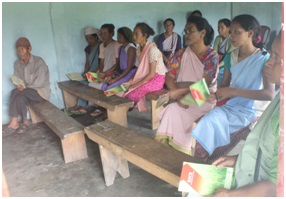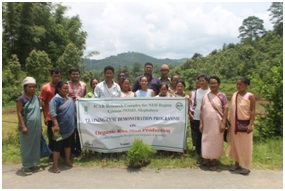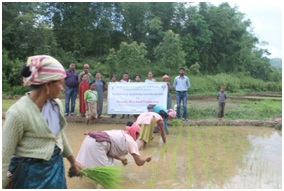Training cum field demonstration on Organic Rice Seed Production
One day training cum demonstration programme on “Organic Rice Seed Production” was organized under the Network Project on Organic Farming (NPOF) by the Division of Crop Production, ICAR Research Complex for NEH Region, Umiam on 6th July, 2018 at Mynsain village, Ri-Bhoi District, Meghalaya with the objective of promoting cultivation of rice organically with the adoption of improved production technology.
Dr. Amit Kumar, Scientist (Plant Breeding) inaugurated the training cum demonstration programme followed by a welcome speech by the headman of Mynsain village. Dr Kumar elaborated that there is a tremendous scope for the organic rice cultivation in Meghalaya as it is being practiced traditionally since many years by tribal farmers. He also explained the benefits of organic cultivation in terms of maintaining soil and crop health and leveraging premium price for organic produce which boost the welfare of tribal farmers without the use or additional investment on agricultural chemicals. He also urged the farmers to incorporate improved production technologies of organic cultivation along with their traditional practices of farming to maintain an ideal balance between higher productivity, ecological health and enhance their income.
Dr. Krishnappa R, Scientist (Crop Physiology) while introducing the immense scope of organic rice in mid altitudes of Meghalaya, emphasized on four (4) important aspects organic cultivation. Firstly, selection of right cultivars/varieties having higher yield potential which is foremost criteria to be followed for ensuring higher productivity. Secondly, right time of sowing which is very crucial for successful organic production system as well as for undertaking appropriate pulse cultivation during succeeding season. He explained that farmers should start land preparation by the last week of May and transplanting of 25-30 days old seedlings should be completed by 15th July. Thirdly, to check unprecedented weed growth in hilly areas, he explained the importance of timely weeding by both manual weeding @ 20 & 45 days after transplanting and also by mechanical cono-weeder @ 30 and 60 days after transplanting. Lastly, for meeting nutrient management of organic rice with 60:60:40 N:P2O5:K2O for optimum crop growth farmers need to apply 10 t/ha FYM or 5 t/ha FYM + 5 t/ha azolla at the time of transplanting in three split stages( at the time of transplanting, at tillering and panicle initiation stages) and applying full basic dose of P2O5 by providing 250 kg/ha of rock phosphate during transplanting and application of K rich organic sources at two stages the time transplanting (3/4th) as well as panicle initiation stages (1/3).
Dr. Utpal Dey explained that the additional advantage of the basal application of green Azolla manure either @ 10-12 t/ha as sole source at the time of transplanting or 2-3 t/ha as dual crop which help to increase soil N by 50-60 kg/ha and also significantly reduce the investment on 30-35 kg of nitrogenous fertilizer and crucially help to maintain better soil health and fertility. Further, he also explained that the frequent occurrence of blast disease in organic rice can be controlled by root dipping of seedlings in a solution prepared by mixing 10 g of Trichoderma harzianum+ Pseudomonas fluorescens in 1litre of water for 15-30 minutes. He also highlighted the importance of seed treatment bio-control agent mixture (Trichoderma harzianum+ Pseudomonas fluorescens) @ 12-15 g/kg seed for controlling such diseases in rice cultivation. Miss Daphibanri Lyngdoh gave a description of the important varieties suitable under different situations of this region. She explained that for lowland conditions, varieties such as Shahsarang-1, Megha SA-2 are found to be suitable having a yield potential of about 4.0-4.5 t/ha and for high altitude conditions Bhalum, Megha rice-1 is found to be suitable having a yield potential of 3-3.5 t/ha. She asked the farmers to do line sowing/transplanting of rice at a spacing of 20 cmx20 cm which assure to give higher yield as compared to broadcasting method. She also told the advantage of line sowing of rice for cultivation of rabi crops such as pea, lentil, mustard etc under no-till rice fallows which in turn provide an additional income to the farmers.
After the inaugural programme, demonstration of line sowing of rice was undertaken in one of the farmers’ field for better understanding and creating awareness of the farmers. Altogether 25 farmers attended the training cum demonstration programme and related rice leaflets, seedlings of rice (var.Shahsarang-1) were distributed to the farmers.



